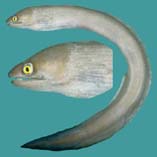| Family: |
Muraenidae (Moray eels), subfamily: Muraeninae |
| Max. size: |
39 cm TL (male/unsexed) |
| Environment: |
reef-associated; marine; depth range 0 - 43 m |
| Distribution: |
Indo-Pacific: East Africa to the Society Islands, north to the Amami Islands in Japan and the Marshall and Hawaiian islands, south to the southern Great Barrier Reef. |
| Diagnosis: |
Dorsal spines (total): 0-0; Dorsal soft rays (total): 0-0; Anal spines: 0-0; Anal soft rays: 0-0; Vertebrae: 110-124. Uniformly brown moray that differs from G. monochrous by having lower jaw teeth that are finely serrated on their posterior margins.
Description: Characterized by diffuse dark brown ring around the eye; body depth at gill opening 11-15 in TL; origin of dorsal fin anterior to gill opening; anus anterior to middle of body; single row of compressed and triangular jaw teeth; larger teeth serrate; usually two median teeth at front of upper jaw, first is conical and short, second is slender canine (Ref. 90102). |
| Biology: |
Occurs on reef flats as well as lagoon and seaward reefs to a depth of at least 43 m. Benthic to 40 m (Ref. 58302, 75154). Cryptic (Ref 90102).Minimum depth reported taken from Ref. 86942. |
| IUCN Red List Status: |
Least Concern (LC); Date assessed: 18 August 2011 Ref. (130435)
|
| Threat to humans: |
harmless |
Source and more info: www.fishbase.org. For personal, classroom, and other internal use only. Not for publication.

